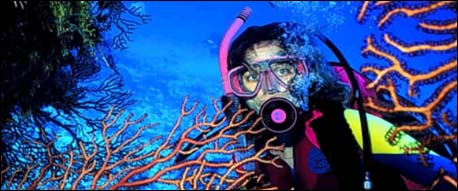
Scuba
Jobs
SPONSORED
LINKS
Training and Certification
Before taking a dive, enthusiasts must gain
certification by passing a course offered by a
certified scuba diving agency. All agencies
require that participants be proficient swimmers,
in reasonably good health, and at least 12 years
old.
The course typically consists of classroom work,
practice in a pool or other confined body of
water, and dives in the open water, usually in a
large lake or the ocean. In the course, students
learn to use diving equipment, to equalize air
pressure as they descend, to swim efficiently
underwater, and to ascend safely. They also learn
how to communicate underwater with hand signals.
Scuba diving should always be practiced with at
least one other person, and partners should remain
together throughout the dive. Certification
courses teach divers the rules and advantages of
the buddy system. Diving partners learn to
double-check each other's equipment, share a
single air supply, and assist one another should a
problem occur.
Controlling breathing rate is also important.
During exercises in water, diving students
practice breathing in a slow, continuous manner.
Most hazards can be avoided if divers follow the
safety procedures taught in certification courses
and do not attempt dives beyond their ability and
experience.
To become certified, diving students must pass a
written exam and a swimming proficiency test, and
successfully demonstrate newly mastered skills in
four open-water dives. Proficient divers then
receive a certification card that allows them to
make unsupervised dives, refill air tanks, and buy
diving equipment worldwide. Stores that sell
diving equipment and businesses that operate
diving tours require this proof of certification.
Scuba Diving

Saturation Diving
Commercial or
scientific divers live in an pressurized chamber,
for extended period, called saturation diving. The
diver's body becomes saturated with gas mixtures
corresponding to the working depth. Divers can
therefore remain under a constant pressure for
weeks or months, rather than go through a lengthy
decompression during and after each dive.
The hazards in saturation diving are much like the
hazards of living in a space station. Inhabitants
depend on life support systems for their air and
power supply. Should medical or mechanical
difficulties occur, a risky evacuation procedure
that requires a series of decompression stops is
the only way to bring divers to the surface
safely.
Snorkeling
Is a common form of diving on the surface or just
below on the surface. A snorkel is a tube that
allows the diver to breathe while floating at the
water's surface. One end fits in the diver's mouth
and the other end extends above the water.
Equalization
When a diver descend, the surrounding water
pressure increases, causing a slight discomfort,
or squeeze, in their ears and sinuses. Divers
relieve this discomfort by holding their noses and
blowing gently. This technique is called
equalization as it equalizes the pressure within
the divers' bodies with that of the surrounding
water, allowing them to proceed safely.
VIEW SCUBA GUIDE

|